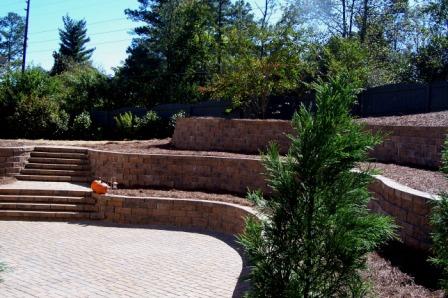Stylish Elegance of Brick Retaining Walls

Ask about the most basic component for building any structure, and chances are, there will be a universal answer: bricks. Bricks, hard blocks made from clay, are proven materials in house and building constructions. Hence, there is no reason to doubt their efficiency when it comes to retaining walls.
Indeed, brick retaining walls are one of the most popular choices among many
homeowners. First, it’s because bricks are the first things that come to mind whenever a person is confronted with the prospect of creating a wall. And second, it’s because bricks allow a lot of flexibility with design elements that can eventually be manipulated to create beautiful gardens.
Retaining walls are important for gardeners and landscape artists who wish to separate their gardens from the rest of the backyard. Sometimes, these gardens are placed in elevated areas. The purpose of retaining walls is to support the ground upon which the plants will reside. But there are more uses for retaining walls. If created with the right design in mind, they can enhance the splendor of any garden.
And this is where brick retaining walls excel. Since bricks are malleable materials, at
least when they have yet to harden, they can be manipulated to form a variety of shapes that will perfectly carry out the design you have in mind. Also, their surface texture will allow you to apply, and play with; paint to come up with colorful structures that will bring any environment to life.
However, you shouldn’t just build brick retaining walls based on how you have always pictured them to be. Establishing these walls is easier said than done. There are sound engineering principles you should be observing.
The first step you have to take is to dig a sizable trench upon which your brick retaining walls will be built. The trench should be deep enough to support the weight of the walls, and to make it formidably resistant against the weight of the soil it will be supporting. Concrete with steel rebar must be installed into the trench. This concrete foundation will provide a level base for the concrete blocks and brick face forming the brick retaining wall.
Also, bear in mind that retaining walls above 3 feet are subject to some permit
regulations in certain areas, more specifically, territories that experience frequent
seismic activities. Do consult with your local regulatory board before proceeding with the construction of your retaining wall.
A 4” drain pipe must be placed at the wall bottom on the back side of the Wall. Install gravel from the drain pipe and extending up to the top of the wall. This will help to prevent water pressure from pushing the over. It is also a good idea to provide weep hole along the bottom of the wall to allow additional drainage.
Conclusion: If the home has brick on the outside, try to match the same brick color
into new retaining walls. It is important to carry the same house building material out into the landscape. This will help to unify the entire property. Brick, stone and
concrete caps can be used to finish off the top of the wall. Please note, brick retaining walls may look great but they are expensive to construct because of the cost for the concrete footing.
Order Your New Landscape Design Today!
Always Design Before You Plant!
Have A Great Story About This Topic?
Do you have a great story about this? Share it!

Privacy Disclaimer About Contact This Site Built: Solo Build It
Copyright © 2003 - 2023 by Web-Landscape-Design-Ideas.com.
All rights reserved.


